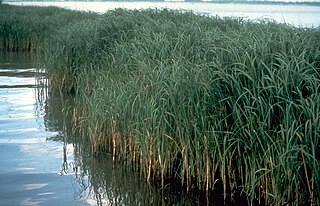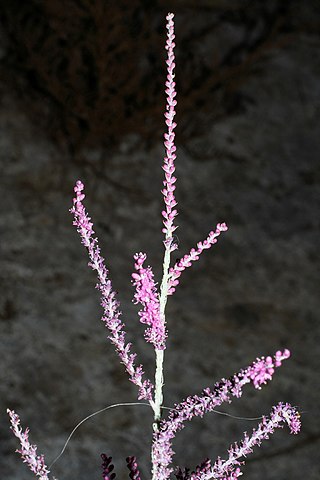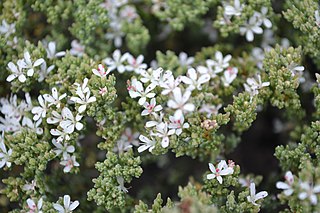
A halophyte is a salt-tolerant plant that grows in soil or waters of high salinity, coming into contact with saline water through its roots or by salt spray, such as in saline semi-deserts, mangrove swamps, marshes and sloughs, and seashores. The word derives from Ancient Greek ἅλας (halas) 'salt' and φυτόν (phyton) 'plant'. Halophytes have different anatomy, physiology and biochemistry than glycophytes. An example of a halophyte is the salt marsh grass Spartina alterniflora. Relatively few plant species are halophytes—perhaps only 2% of all plant species. Information about many of the earth's halophytes can be found in the ehaloph database.

Soil salinity is the salt content in the soil; the process of increasing the salt content is known as salinization. Salts occur naturally within soils and water. Salination can be caused by natural processes such as mineral weathering or by the gradual withdrawal of an ocean. It can also come about through artificial processes such as irrigation and road salt.

The genus Tamarix is composed of about 50–60 species of flowering plants in the family Tamaricaceae, native to drier areas of Eurasia and Africa. The generic name originated in Latin and may refer to the Tamaris River in Hispania Tarraconensis (Spain).

Frankia is a genus of nitrogen-fixing bacteria that live in symbiosis with actinorhizal plants, similar to the Rhizobium bacteria found in the root nodules of legumes in the family Fabaceae. Frankia also initiate the forming of root nodules.

Intertidal ecology is the study of intertidal ecosystems, where organisms live between the low and high tide lines. At low tide, the intertidal is exposed whereas at high tide, the intertidal is underwater. Intertidal ecologists therefore study the interactions between intertidal organisms and their environment, as well as between different species of intertidal organisms within a particular intertidal community. The most important environmental and species interactions may vary based on the type of intertidal community being studied, the broadest of classifications being based on substrates—rocky shore and soft bottom communities.
Euryhaline organisms are able to adapt to a wide range of salinities. An example of a euryhaline fish is the molly which can live in fresh water, brackish water, or salt water.

A halosere is an ecological succession in a saline water saline environments. An example of a halosere is a salt marsh.
Coastal strand is a plant community of flowering plants that form along the shore in loose sand just above the high tide line.

A brackish-water aquarium is an aquarium where the water is brackish (semi-salty). The range of "saltiness" varies greatly, from near freshwater to near marine and is often referred to as specific gravity (SG) or salinity. Brackish water aquaria is a popular specialization within the fishkeeping hobby. Many species of fish traded as freshwater species are actually true brackish species, for example mollies, Florida flagfish, and some cichlids such as chromides and black-chin tilapia. There are also several popular species traded purely as brackish water fish, including monos spp, scats, archerfish, and various species of pufferfish, goby, flatfish, and gar. Generally, aquarists need to maintain a specific gravity of around 1.005 to 1.010 depending on the species being kept, but practically all brackish water fish tolerate variations in salinity well, and some aquarists maintain that regularly fluctuating the salinity in the aquarium actually keeps the fish healthy and free of parasites.
California's coastal salt marsh is a wetland plant community that occurs sporadically along the Pacific Coast from Humboldt Bay to San Diego. This salt marsh type is found in bays, harbors, inlets, and other protected areas subject to tidal flooding.

Phoenix reclinata, the wild date palm, Arabian date palm or Senegal date palm, is a species of flowering plant in the palm family native to tropical Africa, the Levant, the Arabian Peninsula, Madagascar and the Comoro Islands. It is also reportedly naturalized in Florida, Texas, California, Nevada, Arizona, New Mexico, Mexico, Puerto Rico, Bermuda, Iberian Peninsula, Italy, Albania, Greece, Turkey, and the Leeward Islands. The plants are found from sea level to 3000 m, in rain forest clearings, monsoonal forests and rocky mountainsides.

Atriplex hymenelytra, the desert holly, is silvery-whitish-gray shrub in the family Amaranthaceae, native to deserts of the southwestern United States. It is the most drought tolerant saltbush in North America. It can tolerate the hottest and driest sites in Death Valley, and remains active most of the year.

Mesembryanthemum crystallinum is a prostrate succulent plant native to Africa, Sinai and southern Europe, and naturalized in the New World. The plant is covered with large, glistening bladder cells or water vesicles, reflected in its common names of common ice plant, crystalline ice plant or ice plant.

Caryophyllales is a diverse and heterogeneous order of flowering plants that includes the cacti, carnations, amaranths, ice plants, beets, and many carnivorous plants. Many members are succulent, having fleshy stems or leaves. The betalain pigments are unique in plants of this order and occur in all its families with the exception of Caryophyllaceae and Molluginaceae.

Tamarix hispida, commonly known as Kashgar tamarisk, is a species of tamarisk in the Tamaricaceae family. It is found in Central Asia. The foliage has a bluish-green color and the plant flowers in autumn.

Cynomorium is a genus of parasitic perennial flowering plants in the family Cynomoriaceae. The genus consists of only one species, Cynomorium coccineum. Its placement in the Saxifragales was resolved in 2016 with the help of nuclear, plastid, and mitochondrial sequences obtained from next-generation sequencing. Common names include the misleading Maltese fungus or Maltese mushroom; also desert thumb, red thumb, tarthuth (Bedouin) and suoyang (Chinese). A rare or local species, it grows in dry, rocky or sandy soils, often in salt marshes or other saline habitats close to the coast. It has had a wide variety of uses in European, Arabian and Chinese herbal medicine.

Frankenia is the only genus in the Frankeniaceae family of flowering plants. Other genera have been recognized within the family, such as Anthobryum, Hypericopsis and Niederleinia, but molecular phylogenetic studies have consistently shown that they all belong inside Frankenia. Frankenia comprises about 70–80 species of shrubs, subshrubs and herbaceous plants, adapted to saline and dry environments throughout temperate and subtropical regions. A few species are in cultivation as ornamental plants.

Tamarix canariensis is a species of flowering plant in the family Tamaricaceae. It is a shrub or small tree up to 4 m tall. It was previously said to be native to parts of Macaronesia, northern Africa and south-western Europe, but is now considered only to be found in the Canary Islands, the African and European species being Tamarix gallica. It was first described by Carl Ludwig Willdenow in 1816.

Myricaria is a genus of flowering plants of the family Tamaricaceae, native to Eurasia.

Tamarix africana, the African tamarisk, is a species of tree in the family Tamaricaceae. They have a self-supporting growth form and simple leaves. Individuals can grow to 6.3 m.

















